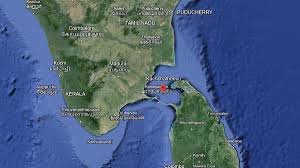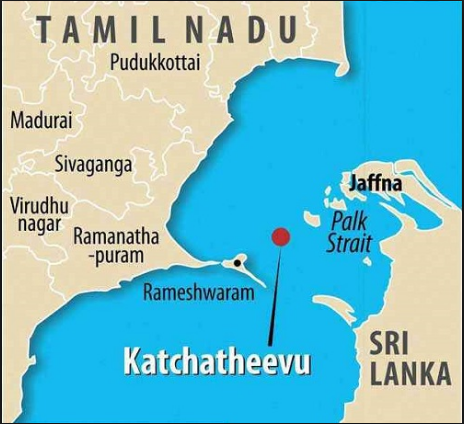
Kachchatheevu Island Row
Kachchatheevu Island Row
GS-2: International Relations
(IAS/UPPCS)
Relevant for Prelims:
Katchatheevu Island, Dhanushkodi, Rameshwaram, Palk Strait.
Relevant for Mains:
Katchatheevu Island dispute, related political flashpoints, agreement between India and Sri Lanka, importance of Katchatheevu Island for India, way forward, conclusion.
02/04/2024
Source: Indian Express, The Hindu
Mains Question:
Analyze the geopolitical importance of Katchatheevu Island for India. Discuss the way forward for resolution of the Katchatheevu island dispute. (250 words)
Reference:
In recent times Katchatheevu, a small island between India and Sri Lanka in the Palk Strait, is again in the news as a political flashpoint in Tamil Nadu.
- Katchatheevu Island has been a disputed area between India and Sri Lanka since the British era. Fishermen from both countries used Katchatheevu Island, which was initially part of the Madras Presidency.
- After independence, a dispute once again broke out between India and Sri Lanka regarding fishing rights around this island and the Indian government wants to take control over this island again.
What is the political flashpoint related to this issue:
- Actually, this island has become an issue of nationalism for the ruling government since August 2014 and the Indian government under the leadership of PM Modi wants to include this island in the Indian territory so that the interests of Indian fishermen can be nurtured and China's geopolitical dominance in this region can be ended.
- It is noteworthy that Katchatheevu Island was handed over to Sri Lanka under the Bilateral Generosity Act of 1974.
- Actually the strategic importance of this island was very less during the settlement, but in the last decade, the geopolitical dimensions changed due to the growing clout of China and its growing influence on Sri Lanka, making it a place of strategic importance for India.
Accord between India and Sri Lanka:
- In June 1974, the then Prime Ministers of India and Sri Lanka, Indira Gandhi and Sirima R.D. Bandaranaike had signed an agreement to define the boundary between their countries in the waters from the Palk Strait to Adam Bridge.
- A joint statement issued on June 28, 1974, announced that the border was established "in accordance with historical evidence, international legal principles and precedents." Furthermore, the statement indicated that "the range is one mile off the west coast of uninhabited Katchatheevu."
- This agreement marked the culmination of negotiations that had been going on since October 1921, initially conducted between the governments of Madras and Ceylon.
About Katchatheevu Island:
Historical Background:
- Medieval period: During the early medieval period, the island was under the control of the Jaffna Kingdom of Sri Lanka. However, by the 17th century, it had changed to the Ramnad Kingdom, based in Ramanathapuram, India.
- Katchatheevu was once a part of Ramnad Zamindari. The princely state of Ramanathapuram (or Ramnad) was established in 1605 by the Nayak dynasty of Madurai.
- It consisted of 69 coastal villages and 11 islets, including Katchatheevu.
- A copper plaque issued by Kuthan Sethupathi, the sovereign of Ramanathapuram between 1622 and 1635, testifies to Indian ownership of the area extending up to Thalaimannar in present-day Sri Lanka, including Katchatheevu, which was a source of regular revenue for the Sethupathi dynasty .
- In 1767, the Dutch East India Company signed an agreement with Muthuramalinga Sethupathi to lease the island.
- In 1822, the British East India Company took the island on lease from Ramaswamy Sethupathi. Under British rule, the island was administered as part of the Madras Presidency.
- Since the outbreak of the Lankan civil war in 1983, the island has been a battleground for fighting between Indian Tamil fishermen and the Sinhalese-dominated Lankan navy.
Origin:
- This island was born due to the volcanic eruption of the 14th century.
Geographical location:
- A little more than twenty miles north of Dhanushkodi is the disputed territory of Katchatheevu (meaning 'barren island' in Tamil), an uninhabited island of 285 acres. It lacks a source of fresh water, making it uninhabitable.
- It is located across the Palk Strait about 33 km north-east of Rameshwaram, India, and about 62 km south-west of Jaffna, the northernmost point of Sri Lanka.
- Ownership: Since 1921, both India and Sri Lanka have claimed ownership of the island to limit marine fishing.

Significance of Katchatheevu Island for India:
Economic:
- Fishermen from Tamil Nadu can be provided with economic means of livelihood in this area as Indian Tamil fishermen often face punitive action from Sri Lankan authorities.
- At least 6,184 Indian fishermen have been detained in the last 20 years. Sri Lankan authorities have seized 1,175 Indian fishing boats during the same period.
Tourism:
- The only structure on the island is St. Anthony's Church, built in the early 20th century. Annually, during a festival, Christian clergy from both India and Sri Lanka lead joint services, attracting pilgrims from both countries.
- In 2023, 2,500 Indian devotees traveled from Rameshwaram to Katchatheevu to participate in the festival.
Strategic:
- India can build a base for the Navy to keep an eye on the neighboring countries in this region. China's expansion can be stopped.
Way forward:
- Both countries should adopt a common approach for a peaceful solution so that China cannot take advantage of it.
- India should strongly oppose Sri Lanka to stop the draconian step of imposing penalty of Rs 1 crore as bail money on fishermen.
- The island should be agreed to for "coordinated patrolling" by naval forces of both countries so as to prevent illegal exploitation of marine biological resources.
- The accused should be detained and handed over to their respective countries, where they are punished for the same crime rather than in the harsh and barbaric conditions of the other country.
- Considering the seriousness of the situation, it is imperative to focus on the fishermen and provide them with sustainable alternatives to bottom fishing, which will secure the future of both Indian and Sri Lankan fishermen without jeopardizing the existing bilateral relations.
Conclusion:
Katchatheevu Island is important for marine biological resources and strategically for both the countries, hence this dispute should be resolved through mutual discussions. However, the Katchatheevu dispute is too complex to be reduced to chauvinistic discourses or narrow concerns, as it is a relic of the legacy of the geopolitical entanglements of colonial South Asia.
-----------------------------------------------------------